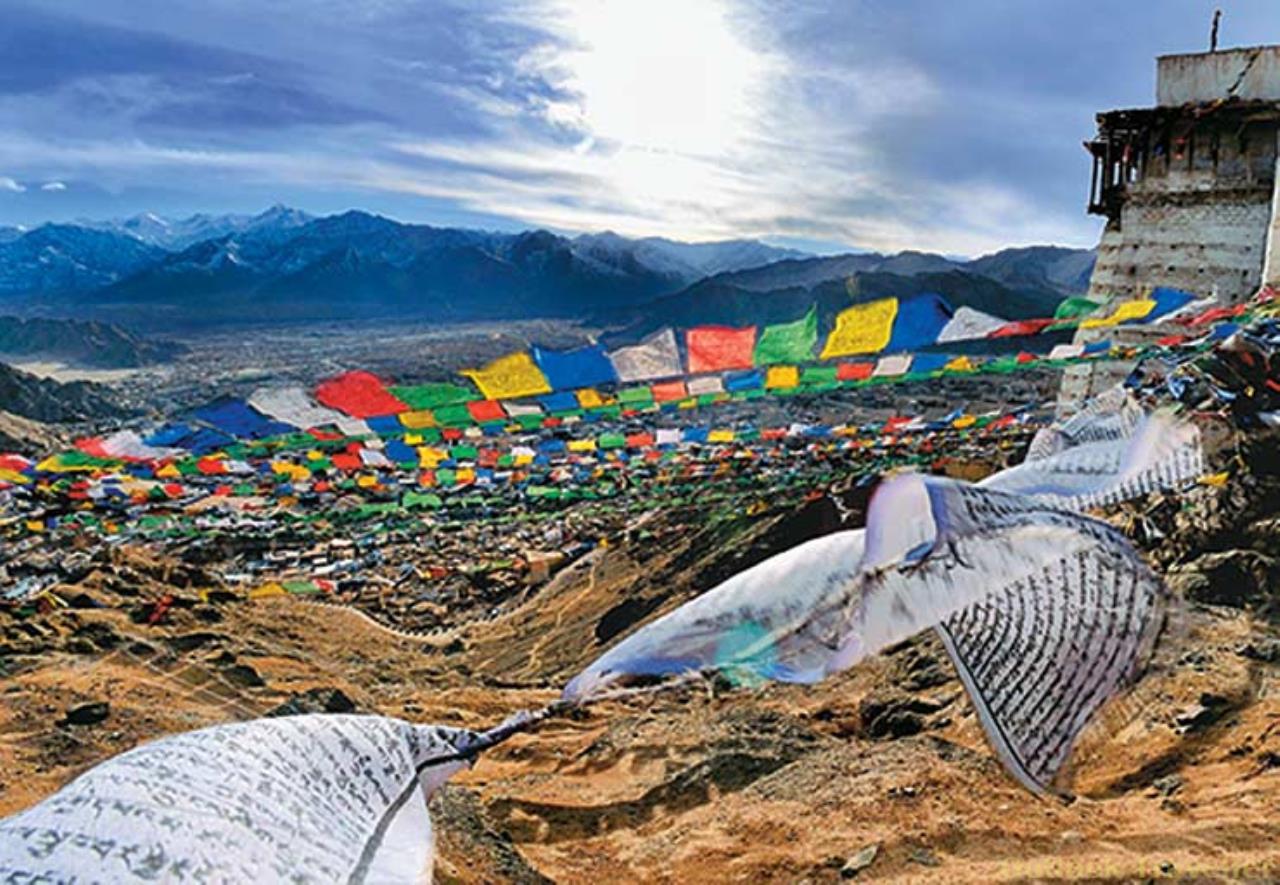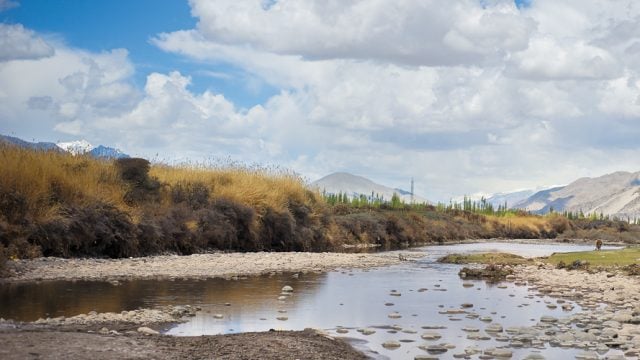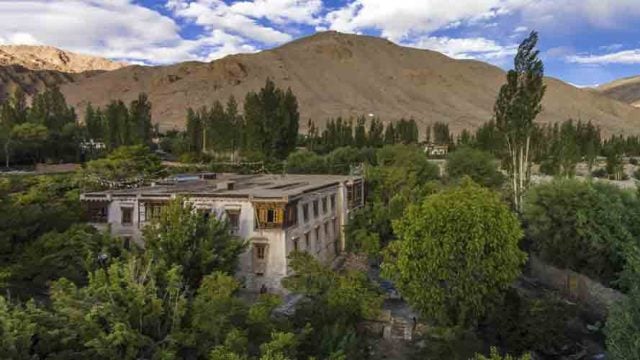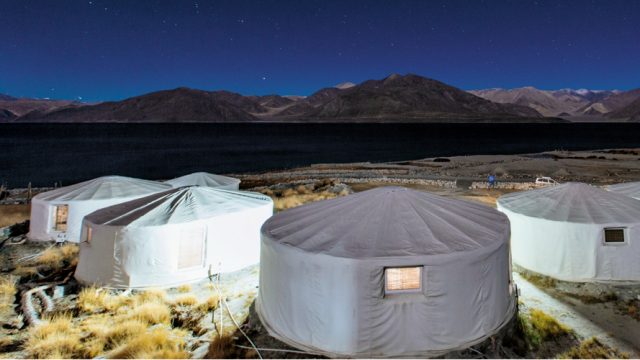This ancient pitstop on the storied Silk Road is a circuit in its own right. Its most
Six kilometres from Leh town (we did say this was a circuit), Choglamsar began as a settlement of Tibetans fleeing China across the border, an exodus that continues to this day. The houses are neat, the sewage system works and the houses are filled with warm, welcoming folk. The Sankar Gompa, an easy 2.5km walk from town, houses the Kandshur, a complete repository—in 108 volumes—of Buddhist teachings. Around 13km from town, the Shey palace and gompa is noted for a Sakyamuni Buddha touted to be the second-largest Buddha in Ladakh. Though the second storey of the monastery is usually locked, a monk should be able to show you the prayer room here—its walls are adorned with beautiful murals.
Hotels in Leh range from the, well, grand Grand Dragon (from Rs 6,000; www.thegranddragon ladakh.com) to popular haunts like Kang-Lha-Chen (Rs 2,420; 01982-252144) and Hotel Mogol (from Rs 2,200; www.hotelmogol.com) and the modest but well-regarded Oriental (from Rs 600; www.orientalguesthouse.com). Set aside a day to acclimatise, and do the sights over the next two days. Or take as long as you like.
Go Gompa
It doesn’t take long to get gompa-d once you’re in Ladakh. In fact, all the major monasteries on the tourist trail can be covered in a mere two days, with Leh as your base.
Day 1: Leh-Hemis-Thiksey-Matho-Chemerey-Leh Hemis is the best known, richest and largest monastery in Ladakh, an easy 40km drive from Leh. Share taxis and buses are easy to get, especially during its annual two-day festival (June 21-22 this year). The festival is a visual treat, and the monastery even unfurls a ‘duplicate’ thangka every year to please visitors (the original thangka is only unveiled every 12 years). The monastery is rumoured to have in its possession a parchment which mentions a boy named Issa who stayed there for several years. Hemis is also one of the few monasteries built not atop a hill but on its flank, probably to keep its location secret and its riches safe. Thiksey is a bit smaller than Hemis but much more impressive, rising tier by tier on an open crag next to the Indus. The views from its terrace are superlative. Try and reach Thiksey at first light and you can witness the higher lamas begin their day with ritual conch blowing. The only gompa belonging to the Saskya-pa sect in Ladakh, Matho is situated close to a gorge opposite Thiksey. The highlight is its museum, which has a rich collection of thangkas. Just far enough and small enough to escape the attention of most tourists, Chemerey is 45km from Leh on the way to Chang-la (and onwards to Pangong Tso). The strikingly beautiful monastery is perched on a bare hillock, with the monks’ quarters flowing down in steps on one side.
Day 2: Leh-Basgo-Alchi-Leh Basgo, once the capital of lower Ladakh, is a fortified complex that lies in ruins today, 60km from Leh. Within the ruins is a gompa whose murals date to the 16th century. The presiding deity, a Maitreya Buddha, is said to have a very beautiful face, though it is not very easily viewed from the courtyard, and you’ll have to climb a flight of rickety steps to an alcove to view it. The 11th-century Alchi monastery was once a great seat of learning. Today, it boasts the most beautiful frescoes in all of Ladakh. For visitors, carrying a torch is a must if they wish to appreciate the craftsmanship on display.
Lakes placid
Ladakh’s Changthang plateau is home to its spectacular, and extremely popular, lakes circuit. Basic accommodation at each of the lakes is available but it’s best to let your operator organise this for you.
Day 1: Leh-Chang-la-Pangong Tso Pangong Tso, about 240km (6hrs) from Leh on a very good—and very scenic—road, is most popular with tourists, though perhaps not the most striking. At 144km, it’s pretty long, and only a third of it lies in India. Though most visitors return to Leh in the evening, it is best to get a 24-hour permit from the ADC and spend the night at one of the homestays in Spangmik, a tiny village on the banks of the lake.
Day 2: Pangong Tso-Leh Return to Leh and overnight at Leh.
Day 3: Leh-Tso Moriri From Leh head on the Leh-Manali Road to Upshi and from there to Chumathang (where you can stop for the hot springs). When you reach Mahe Bridge, turn right towards Tso Moriri. By far the most beautiful of the lakes, Tso Moriri sits in an expansive valley surrounded by lush marshes. This Ramsar site attracts a host of migratory birds in summer. Patient visitors will be rewarded with sightings of bar-headed geese, ruddy shelducks and the black-necked crane. The village of Korzok on the banks of this lake offers comfortbale tented accommodation.
Day 4: Tso Moriri-Tso Kar Head to Tso Kar via Puga. The heavily brackish Tso Kar is a favoured breeding ground for migratory birds as well as a haunt for a small pack of wolves. A couple of tour agencies have put up tented accommodation here.
Day 5: Tso Kar-Leh From Tso Kar, head on to the new road via Dat that connects to the Manali-Leh Road, cross Tanglang-la and proceed to Leh.
Classic treks
Markha Valley: Few treks in Ladakh can match up to the variety—in topography, local flavour or opportunities to spot wildlife—that this hike offers. A fair share of river crossings and lofty passes, not to mention the fact that each day entails about seven hours of walking, makes it moderately challenging. The highlights of the trek are camping at the tiny hamlet of Zingchen, the scenic route through the Hemis National Park, the breathtaking views from atop Kanda-la and the multi-coloured mountains that present themselves after the cable car crossing at Chilling. The 10-day trek starts at Spituk and ends at Hemis, after taking in the vertigo-inducing gorges beyond Kongmaru-la.
Darcha-Padum: The all-weather road to Leh via Kargil will consume this infinitely beautiful route very soon, so go now. Beginning from Darcha in Himachal Pradesh and ending at Padum, in Ladakh’s Zanskar region, road work has made much of the trail a lot easier, though no less beautiful. The Shinkun-la, the only pass to be crossed, marks the beginning of the Trans-Himalaya. Like all treks in the region, a decent level of physical fitness is demanded to complete this eight-day route, though ample villages along the way soften the blow of a tiring walk.
Likir-Tingmosgang: A trek that is suitable for people of all fitness levels, this is more like a four-day jaunt scouting for monasteries—of which there are several on offer. And there are two passes as well—Hemis Shukpachen and Maptak-la—enough to transform what would be just another trip into a ‘trek’. Apart from Likir and Tingmosgang, the monasteries on the way are Rizong, Tseskarmo and Khatsa. Those who don’t mind lugging their rations along can easily complete this trek without a guide, though finding the monasteries will require some assistance from locals along the way.
Khalsar-Thakthak: The Nubra valley is not really a hotspot for trekking but this route is popular, as it offers dramatic views and a range of topography within the span of a week. As the weather in Nubra is not as harsh as the rest of Ladakh, this trek can be attempted by almost anyone. The trek begins at Khalsar and ends at Thakthak, taking in the Samtanling monastery. The only really difficult stretch of the trek is the crossing of the Wari-la, a nearly 5,000m-high pass. The landscape ranges from barren gorges to lush valleys heavy with harvest and hemmed in by willow, apricot and poplar groves. Given the thin trekker traffic, chances of seeing bharal and ibex are high on this trail. This is also the only route on which locals claim sightings of the Tibetan lynx, a cat infinitely more shy than the popular snow leopard.
Road to Nubra
With an average elevation of 3,500m, it may not exactly be balmy, but the Nubra valley is noted for its pleasant days and fewer extremes of temperature. And although it’s every bit a high-altitude desert like the rest of the region, the landscape can be startlingly lush along the rivers and around settlements.
Day 1: Leh Explore Leh and get your permits for Nubra (your operator can do this for you).
Day 2: Leh-Khardungla-Diskit The journey to Diskit, where you’ll be based in Nubra, takes around five hours. You can stay at Hotel Olthang (Rs 800/dbl; 9469176104, 01980-220025). Overnight at Diskit.
Day 3: Diskit Visit Diskit Gompa. A road has been built, so cars go all the way. Tip: There is a small wetland behind the hill atop which the monastery sits, where many migratory birds make their home. It’s a bit of a slog making your way through the seabuckthorn bushes, but for birders, worth it. After visiting the monastery, head to Panamik, stopping at the monastery on the way to the hot springs. Overnight at Diskit.
Day 4: Hunder Head to the Hunder sand dunes to ride a camel—the Bactrian two-humped variety. Explore the underbrush, where foxes, hares and other smaller animals are easily spotted. Visit the monastery near Hunder. Overnight at Diskit.
Day 5: Return to Leh. OR Diskit-Turtuk-Diskit Get your permit extended by a day from the SDO in Diskit and head to Turtuk, four hours at a leisurely pace from Hunder. Turtuk is among the greenest areas in Ladakh and a recent addition to the tourist map. Accommodation might be a problem, so people could consider heading back to Hunder or Diskit after the popular photo-op at the border. Return to Leh the next day.
Village walks
Ladakh lives in its villages. And veterans of the Dah-Hanu valley, north of Leh, argue that its unspoilt, green settlements along the Indus merit a separate two- to three-day trip. With Biama and Dah as base, the area offers some idyllic village walks. No big gompas. No lakes. Just close encounters with the Brokpa—‘hill people’—and a chance to share their bucolic existence. Whitewashed homes, gurgling streams, apricots, barley, monthu tho (a kind of wood rose) flowers and gallons of chhang.
About 160km from Leh, Biama and Dah can be reached in a shared cab (buses can be uncomfortable). Later, one can ask the local guesthouse/camp owners to arrange for a drop back to Leh. A rental car (about Rs 8,000-9,000 for three days), on the other hand, can be a boon, if you plan to add a few more excursions to your walking holiday. All Brokpa villages, which lie between Achinathang and Batalik, require permits—some from the DC of Leh and others from the DC of Kargil, so contact a travel operator beforehand (see ‘The Information’). Set aside one day for the trip from Leh to Biama and another to return to Leh from Dah. The journey, each way, should take six to seven hours.
Day 1: Biama-Sanid-Lastience-Biama Having arrived the day before at Biama and rested overnight at the Aryan Valley Camp (Rs 3,000 for a double, all-inclusive; 9419178890, 01982-228543), head out to Sanid early next morning. The oldest Brokpa settlement, homes at Sanid are speckled on either side of a stream. Lastience is perched above Biama and affords an even better view. Be prepared for a steep climb though. Walk back to Biama before sundown.
Day 2: Biama-Baldez-Dah-Garkhun-Dah The valley tapers beyond Biama, and Dah is just a few kilometres drive down the road. You could stop en route and cross a creaky bridge to Baldez, isolated on the right bank of the Indus. Dah sprawls along a verdant balcony in the gorge with another overhanging terrace of fields above it. Book into the Skybapa Guest House (from Rs 300 per person, per night; 9419815534, 01982-228527). Make the village of Garkhun, beyond the Kargil district checkpost, your next stop. Spend the night at Dah.
Other excursions
If you have a car and can convince the guards at the checkpost to let you through, there’s a lovely military road that leads to Dhuya Chilgi — a spectacular solitary juniper tree, sacred to the Brokpas.
The Balti village of Skurbuchan and the palace of Chiktan could be another detour on the way back to Leh.
From Dah, you could also drive down to Darchiks on the left bank of the river and continue along the same road for another half an hour to reach Gurgurdho, at the border of Ladakh and Baltistan.
The village of Hanu could also be the base for delightful walks to Hanu Yogma and Hanu Goma.
Leh-Srinagar road
The war put Kargil and Drass on the tourist map. But look beyond the obligatory Tiger Hill and Bofors guns, and you’ll discover the pied colours of the Leh-Srinagar road as it segues from Ladakh’s ‘Buddhist east’ to its ‘Muslim west’. Although buses and shared cabs frequently ply on this route, a private taxi is your best bet. Also, check beforehand (at Leh) if the Zoji-la pass is open on the day/time when you’re likely to cross over (the army sometimes shuts it down for maintenance).
Day 1: Leh-Nimo-Basgo-Alchi-Likir-Lamayuru Starting out early from Leh, and follow the Indus until you reach the first pitstop—the village of Nimu, which lies near the confluence of the Zanskar and Indus rivers.
Further ahead lies the settlement of Basgo, a prelude to the monasteries at Likir and Alchi further north. Set aside at least four-five hours to see the Klu Kkhyil Gompa at Likir (a short trek away from the village) and the Choskor monastery at Alchi. Finally, head to Lamayuru, where the oldest gompa in Ladakh still stands. You can also plan your visit to coincide with the Yuru Kabgyat festival at Lamayuru (June 10-11 this year). Stay overnight in the monastery-run Hotel Niranjana (approx. Rs 1,500; 01982-2245055).
Day 2: Lamayuru-Mulbekh-Kargil A two-hour drive from Lamayuru, Mulbekh is the last ‘frontier’ of Buddhist Ladakh. Chamba, Serdung and Gandentse are the three gompas in this dusty little town. After an early lunch, drive to Kargil and check into Caravan Sarai (Rs 3,000 for a double, all-inclusive; 01985-232278). Visit the Munshi Aziz Bhatt Museum, which traces the history of the Silk Route, and take a stroll by the Suru river later.
Day 3: Kargil-Drass-Sonamarg-Srinagar Head out early to Drass, stopping at the war museum en route, with the Tololing peak in the backdrop. Since Drass is barely 150km away from Srinagar, you have the option of driving to Srinagar via Zoji-la and Sonamarg. Else, retrace your way back to Leh via Dah-Hanu (a three-day ride with night halts at Kargil and Dah).
Zanskar
The famed ‘chadar’ walk along the frozen Zanskar in winter isn’t everyone’s cup of tea. And the area is just as thrilling in summer. The flipside of pristine remoteness, though, is a lack of good accommodation. But it’s worth it.
Day 1: Leh-Lamayuru See ‘Leh-Srinagar Road’
Day 2: Lamayuru-Kargil Ditto.
Day 3: Kargil-Padum It’s a scenic journey, though the roads are bad. The scenery is particularly stunning around Panikhar, with views of the Nun and Kun massifs, and entailing the crossing of a glacier that reaches down to the road near Suru Valley. On the way, do stop at the Rangdum monastery. The landscape turns even lovelier beyond Rangdum, as one approaches Penzi-la. The Drang-Drung glacier comes into view. In Padum, stay at Hotel Ibex (Rs 600; 01983-245012).
Day 4: Padum-Stongde-Karsha-Padum Follow the trail along the Zanskar river to the Stongde gompa. The gompa is a bit of a climb, but the views of the valley from the top are beyond compare. After Stongde, a slight bit of off-roading will get you to Karsha, the biggest gompa in Zanskar. It can be seen from miles around and, inside, is an elaborate warren of lanes and stairways.
Day 5: Smaller gompas that can be visited around Padum on this day are Stagrimo and Bardan. It’s a two-day journey back to Leh.
Leh
road-trip
Srinagar





